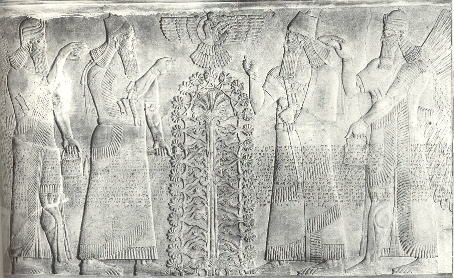"Somebody Cooked Your Goose" - Part Two
A Christmas Study by Tricia Tillin
Christmas is a subject that intrigues, interests and sometimes inflames Christians on both sides of the argument. Those outside Christianity would think it strange that we even have an argument for and against, but throughout the centuries the debate has rolled on, without a firm conclusion. Should we as Christians celebrate the festival that has become known as Christmas?
The bible can be interpreted in various ways on this topic, but is not totally conclusive. The danger lies is being reactionary or harsh. At the end of the day, the bible commands respect for others as well as obedience to God:
Index to the Four Parts
One of the closest links with old religious beliefs is the figure of Santa Claus. He is presented to us today as a jolly, red-cheeked benevolent old gentleman who pops out of the North once a year to give presents to good children. This stereotype has been with us for only a short time, and his history and rise to fame is worthy of attention.
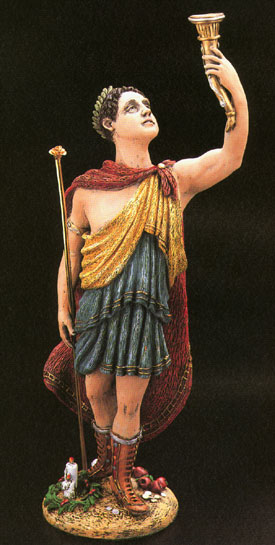 Many
different characters, mythical and historical, have combined into the
Santa we know today, and perhaps the most obvious of these is the King
of the Roman Saturnalia, seen in the illustration. The man chosen to lead the revels and who had
the power to issue any order, no matter how crude or silly, during the
seven days of the feast. This man represented Saturn, the god of the feast
- the identical god in Greece was Cronos the Charioteer.
Many
different characters, mythical and historical, have combined into the
Santa we know today, and perhaps the most obvious of these is the King
of the Roman Saturnalia, seen in the illustration. The man chosen to lead the revels and who had
the power to issue any order, no matter how crude or silly, during the
seven days of the feast. This man represented Saturn, the god of the feast
- the identical god in Greece was Cronos the Charioteer.
Although this man became simply a figure of fun and king for a season, he would in more ancient times have been the chosen human sacrifice to be given at the end of his unfortunate reign. We have hints of this custom from all over the world.
The Aztec ‘king’ would have been a prisoner of war, and he ‘reigned’ for a full year before being offered to the sungod. The Celts chose their victim by lots using a round cake, one portion of which was blackened in the fire.
One account of Saturnalia amongst the Romans at the Danube, written in 1727 and based on the official documents, tells of the choice of a handsome young man thirty days before the feast, dressed in royal attire to resemble Saturn. Thus he went about in public to indulge himself to the full and after the thirty days were ended, cut his own throat on the altar of Saturn. However, so the account goes on to say, in the year 303, the lot fell to a young Christian soldier called Dasius who refused the ‘honour’ of being sacrificed in this way and after threats and arguments was beheaded on 20th November.
King of Fools
In
this country, the king of Saturnalia became the Bishop of Fools (or in Scotland, the Abbott of Unreason) who presided over the Feast of
Fools at Christmastime. (This is also the origin of our April's Fool Day). This was a time of the reverse of the proper order
of things much as it was in Rome, when the monasteries and churches were
scenes of drunken foolishness, the priests wearing masks and reciting
bawdy verses and playing crude tricks upon their superiors. 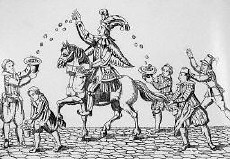
This festival and its counterpart for children at which a boy was elected Bishop became so obnoxious that it was suppressed by the Council of Basle in 1434, but the customs did not die out until the Reformation had taken hold.
A similar figure was the Lord of Misrule, who was the secular version of the Bishop of Fools. However, he was far from the Father Christmas of later years, for at that time Christmas was still an adult festival, a time of feasting, drinking and wenching.
Saint Nicholas aka Sante [Ni]Claus (1)
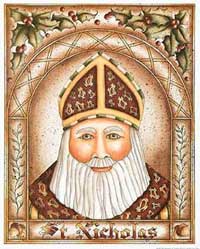 The
man who, all unknowingly, did much to ‘christianise’ and clean up the
Father Christmas idea was Bishop Nicholas of Myra who was born in 270 AD. He was a popular man who, after his death, was canonised and hailed
as a folk hero, a symbol of kindly generosity, especially to children.
The
man who, all unknowingly, did much to ‘christianise’ and clean up the
Father Christmas idea was Bishop Nicholas of Myra who was born in 270 AD. He was a popular man who, after his death, was canonised and hailed
as a folk hero, a symbol of kindly generosity, especially to children.
A much enhanced and polished-up version of the life of Nicholas was written 500 years later by Methodius of Constantinople and it is this biography which has given us our Santa Claus stories.
For instance, it was said the Nicholas responded to the plight of a destitute nobleman who could not afford a dowry for his three daughters by tossing three bags of gold coins through the man’s window at night. One of the bags landed in a slipper which was warming by the fire, and so children today still hang up their stockings in the hope that the generosity of St. Nicholas will extend to them. (2)
St. Nicholas, in his church regalia, was adopted as the Father Christmas of Roman Catholic countries. It was in Amsterdam that he was made into the white-bearded, red-robed "SinterKlauss". However, in our land, the heritage left to us by the Druids and the Romans, and the influence of our Viking ancestors coloured our picture of Santa more than the Catholic St. Nicholas.
In the very distant past, all over the snowy wastes of the Arctic, Siberia, Northern Canada and Greenland, the winter solstice was a time of terror and magic, for it meant the appearance of the shaman who was a sort of witchdoctor and priest. This magician was an important figure at the rites for he was the only person who could travel between earth and heaven to intercede with the gods.
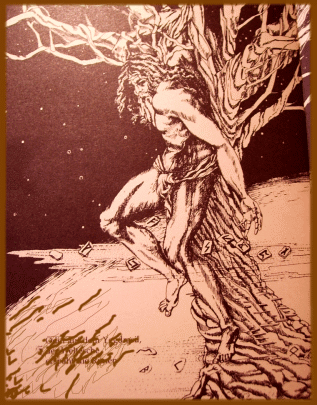
Odin
The fear of the people for the ghoulish shaman was shared by those who knew Odin as their god. He was titled Grim, meaning a hooded man. The British version of this god was Woden, who gave his name to Wednesday, and he was the father of Thor and husband of Frigga (Thursday and Friday!)
Odin was a sort of shaman. He was the All-Father, the Father of war, god of the hanged. He lived in Valhalla, feasting on pork and mead. In his honour, men - especially defeated enemies - were stabbed or speared as they hung on a tree, for the tree was Odin's means of suffering and victory in pursuit of the key to mystic knowledge:
"I know I hung on the windy tree
For nine whole nights
Wounded with the spear;
Dedicated to Odin,
Myself to myself..."
What could be closer to the satanic counterfeit than this? Our Lord, unlike Odin, truly did hang on the Tree, for the salvation of mankind, wounded by the spear of a Roman soldier, dedicated to God the Father as a Sacrifice for sins. But instead of remembering the Cross of Jesus, at Christmas we erect the death-tree of Odin and decorate it with lights and trinkets! In olden times it would be decorated with the skulls of human sacrifices.
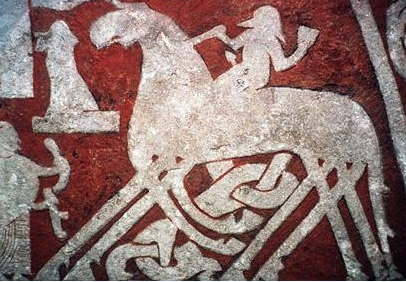 At
the Winter Solstice, Odin in his golden chariot drawn by two white horses,
or riding his eight-legged horse, Sleipnir, would be flying through the
skies in search of souls to take back with him to the region of the dead.
Once more we see the beliefs of Halloween and Christmas merge into one.
But will those who abhor Halloween now see Christmas in the same light?
At
the Winter Solstice, Odin in his golden chariot drawn by two white horses,
or riding his eight-legged horse, Sleipnir, would be flying through the
skies in search of souls to take back with him to the region of the dead.
Once more we see the beliefs of Halloween and Christmas merge into one.
But will those who abhor Halloween now see Christmas in the same light?
To appease Odin, the terrified folks would leave gifts for him, his attendants and his horse, a custom still maintained in some parts today. I recall vividly that my parents would always leave a glass of wine and a mince pie out on the kitchen table before they retired to bed on Christmas Eve - for Father Christmas, whom they of course knew did not even exist! It was a common custom then, and probably is still observed today.
The sinister aspects of the season are still remembered in Odin’s realm: In Germany, St. Nikolaus is accompanied by Knecht Ruprecht, a man with a blackened face who brandishes a chain and carries a sack in which to put naughty children.
The
Finns have Joulupukki, a Christmas goat, who was formerly a black
devil with the same role as Knecht Ruprecht, and in Greece the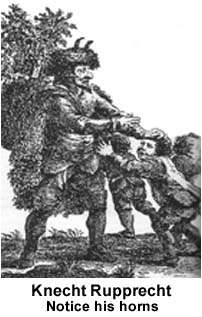 Kallikantzaroi, evil spirits, come from the underworld to terrify
the people. Also, in Amsterdam, St. Nicholas arrives with Black Peter,
and the children leave out carrots and hay for his horse in much the same way as of old.
Kallikantzaroi, evil spirits, come from the underworld to terrify
the people. Also, in Amsterdam, St. Nicholas arrives with Black Peter,
and the children leave out carrots and hay for his horse in much the same way as of old.
Father Christmas Takes Shape
In this country, the various pagan and Catholic strands of the Santa prototypes merged into a vague personification of the season, a Father Christmas figure much like Father Time who appeared in medieval plays.
He was used as a symbol of good living and gaiety in the 18th century in order to ridicule the Puritan objections to Christmas, and he regularly appeared in ‘Punch’ in the 19th century but there was no agreement about his clothes or other features, and there is no mention of stockings, sleighs or chimneys until almost 1900.
It was Queen Victoria and her family who made Christmas a popular family occasion; she and her consort imported many of the Germanic Christmas customs, including the decorated fir tree.
Charles
Dickens, too, popularised the festival with his books. In "A Christmas
Carol" (1843) the Spirit of Christmas (right) is shown as a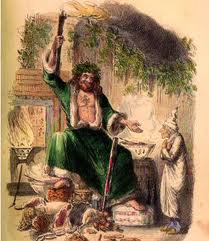 green-robed,
bare-chested Bacchus, his head wreathed with holly. It seems significant
that he gives the figure a rusty ancient scabbard in which there is no
longer a sword. Perhaps he meant to indicate that the bloody sacrifices
of Odin and Saturn were ended at last.
green-robed,
bare-chested Bacchus, his head wreathed with holly. It seems significant
that he gives the figure a rusty ancient scabbard in which there is no
longer a sword. Perhaps he meant to indicate that the bloody sacrifices
of Odin and Saturn were ended at last.
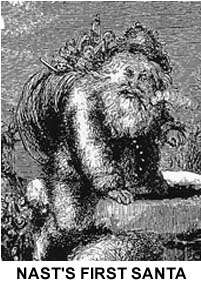 Later
still, an artist called Thomas Nast illustrated the children’s poem, "The
Night Before Christmas" by C. C. Moore which become a firm favourite
after 1891. This poem influenced the festivities of the whole country,
and its illustrations of the white-bearded, red-robed figure of Santa
Claus and his reindeer sleigh fixed his image once and for all.
Later
still, an artist called Thomas Nast illustrated the children’s poem, "The
Night Before Christmas" by C. C. Moore which become a firm favourite
after 1891. This poem influenced the festivities of the whole country,
and its illustrations of the white-bearded, red-robed figure of Santa
Claus and his reindeer sleigh fixed his image once and for all.
The now famous Coke advertising campaign of the 1930's and onward created the Father Christmas that we all know today.
Nevertheless, the Santa familiar to us in this country (England) is a Dutch-American import, and other European countries model their Father Christmas either on St. Nicholas, who appears in full church regalia, or on the darker character of Odin and his spirits who give us once again a reminder of the pagan origins of such customs.
Possibly, reindeer were chosen to pull Santa’s sleigh because they were the most suitable for a Scandinavian ex-god, and symbolic of the snowy wastes of the North.
However, it cannot be overlooked that the reindeer or stag was one of the most important cult animals. The reindeer was sacred to the Scandinavian Mother Goddess Isa or Disa, (3) as was the stag to Diana the Huntress, whose chariot was drawn by four stags with golden antlers.
The Celtic god Cernunnos, below, was sometimes portrayed as antler-horned, because stags were believed to be the enemy of the serpent; that is, it was a symbol of the Messiah, ie. he who will bruise the serpent’s head. Notice that the god is overpowering a snake held in his left hand.
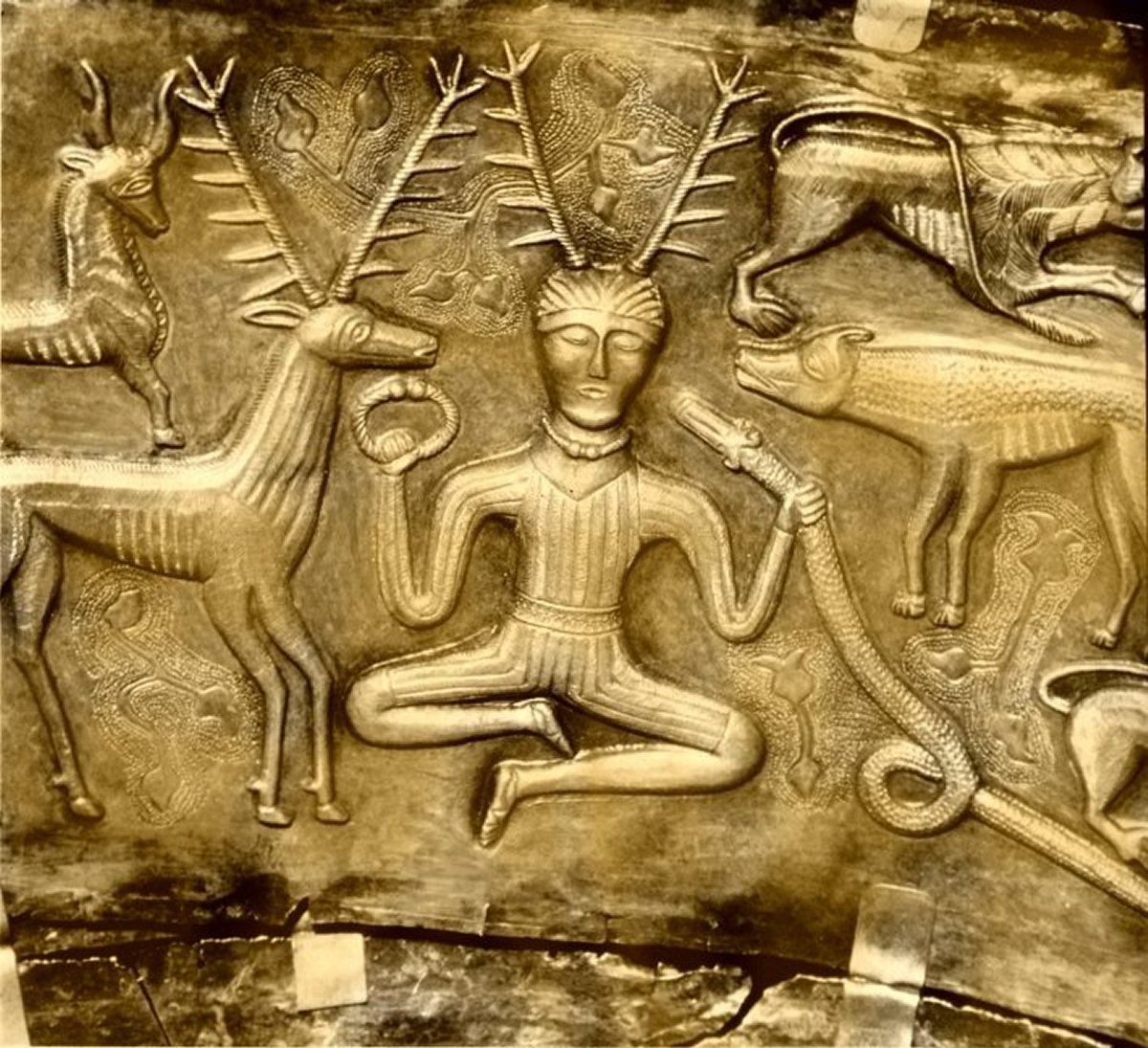
Stag or reindeer sacrifices are among the most ancient. Also, deer skins and antlers were worn by those who sought to communicate with the gods. Although the wearing of skins and horns in ceremonies and folk festivals was severely condemned by certain Church leaders, the practise has continued to this day, for instance in the Abbots Bromley Horn Dance in Staffordshire.
Thus, when the story about a Norse "King Christmas" was immortalised, the symbols of the old gods were reworked into a golden chariot (sleigh) drawn by flying stags (reindeer) and the wise all-father Odin coming to seek or give gifts to mankind on that special Solstice night.
Few would deny the pagan nature of the Christmas tree. Although half-hearted attempts are made to christianise it by topping it with an angel or explaining that it represents the everlasting life of Jesus, it is more often tolerated as an inexplicable, but essential, part of the feast.
In the same category is the Yule log; also the evergreen decorations and the wreaths which are often nailed up on front doors. Of this practise Tertullian wrote: "If thou hast renounced temples, make not a temple of thine own house door".
Jeremiah 10:2-4: "Thus saith the LORD, Learn not the way of the heathen, and be not dismayed at the signs of heaven; for the heathen are dismayed at them. For the customs of the people are vain: for one cutteth a tree out of the forest, the work of the hands of the workman, with the axe. They deck it with silver and with gold; they fasten it with nails and with hammers, that it move not."
The Christmas tree has a long history. It is rooted in pagan worship and the ancient mystery religions. In this 9th century BC relief from the palace of Ashur-nasir-pal II at Nimrud, we can see Ashur-nasir-pal II and a protective spirit taking part in the 'cone-smearing' rite before the Tree of Life. (For all false religions, the "tree of life" is the "Tree of the Knowledge of Good and Evil" in the Garden of Eden that brought about man's fall. It represents human and demonic "wisdom" free will, and psychic power.)
Pine cones are often seen associated with the gods. See this page of photos. This is probably because the pine cone is a tiny representation of the whole fir tree, and thus is the "son" of the "father". Likewise the "yule log" is the child of the tree.
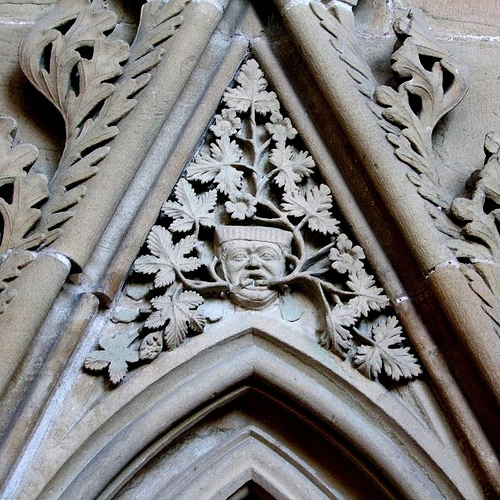 There is evidence that the ancient world saw trees as spirit beings. Thus, they became symbols
of the gods and were honoured, decorated (sometimes with the skulls of slain enemies) and worship took place in a clearing in the forest or a "grove". The bible condemns all this as an abomination that offends God. Notice in particular worship using evergreens "green trees":
There is evidence that the ancient world saw trees as spirit beings. Thus, they became symbols
of the gods and were honoured, decorated (sometimes with the skulls of slain enemies) and worship took place in a clearing in the forest or a "grove". The bible condemns all this as an abomination that offends God. Notice in particular worship using evergreens "green trees":
Deuteronomy 12:2 Ye shall utterly destroy all the places, wherein the nations which ye shall possess served their gods, upon the high mountains, and upon the hills, and under every green tree
Tree worship was especially important in Europe, which was a thickly forested region. The oldest sanctuaries were woods, and it is well known that Druid ceremonies took place in a sacred grove of oak trees. The Celts worshipped the oak, and the Teutonic words for 'temple' all refer to what was first an enclosure around a grove of sacred trees. The word for sanctuary among the druids was nemus, akin to the Latin word, nemus ‘woodland glade, grove of trees.’
Throughout the centuries, trees have been treated with adoration and have received special care and protection; sacrifices are made to them. They came to be seen as the embodiment of a spirit and there were severe penalties for damaging a sacred tree. The superstitious still appeal to these spirits for good luck when they say "touch wood" or "knock on wood" and then touch something made from a tree.
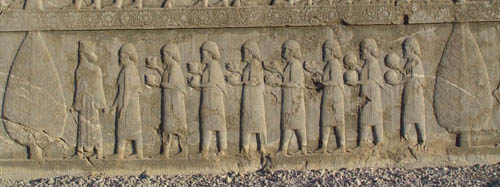
Hakhamaneshian (Achaemenian) Dynasty - Persian Empire (600 - 330 BC)
Our Christmas Tree
Our
own familiar Christmas Tree is a German import. It is mentioned as being
used at Strasbourg in 1605, but did not leave the Rhineland until the
19th century, being introduced into England by Prince Albert
around the year 1840. But since then it's become almost an offense against society NOT to have a tree at Christmas. We see them in every house window, in every town square, and even in 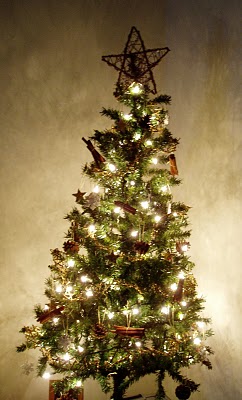
But doesn't it seem strange that every year we cut down a fir tree, drag it inside our house, decorate it with trailing ribbons (tinsel) lights and gold and red balls, and lay gifts underneath it? Why do we crown it with a five-pointed star? Why do some people place a white-robed angel on the top? If we had visitors from space, how would we explain it to them? How does this honour the birth of Jesus Christ?
At first, the tree was not cut down and brought to man, but man went to the tree. There the worshippers gathered to decorate the trees with offerings and to chant their prayers. Afterwards, fires were lit, a feast was enjoyed and orgies took place.
Later, various representations of the tree were used in homes, such as branches and garlands, and wreaths of holly, ivy and evergreens. These too were decorated and on some was placed a white-robed figurine of the virgin who was to be sacrificed to the god.
One of the forerunners of the lighted tree was the wooden pyramid which was used for centuries in Germany and other countries. But now, many local councils are reverting to the pyramid or cone "tree" and using the excuse that it's "safer" than a genuine fir tree. Doubtless the people who pushed this particular abberation recognised its pagan origins.
Decorations
Just as the Egyptian god Osiris was wrapped in linen, the trunk or branches of the sacred tree was wrapped with ribbons. In the myth of Osiris as recorded by Plutarch, Osiris was killed by his brother Seth and his body was floated down the Nile in a wooden coffin (probably a hollowed out tree trunk.) Coming ashore, the coffin became enclosed in a TREE which grew around it. His grieving wife Isis wrapped the trunk in strips of linen and placed it in the temple to be worshipped by the people. The Egyptians therefore depicted Osiris in human form wrapped up as a mummy. He was often shown with green skin, alluding to his role as a god of vegetation. (In the West he is known as the Green Man). He wore the tall conical white crown of Upper Egypt with red plumes on each side. Green, white and red are the traditional colours of Christmas.
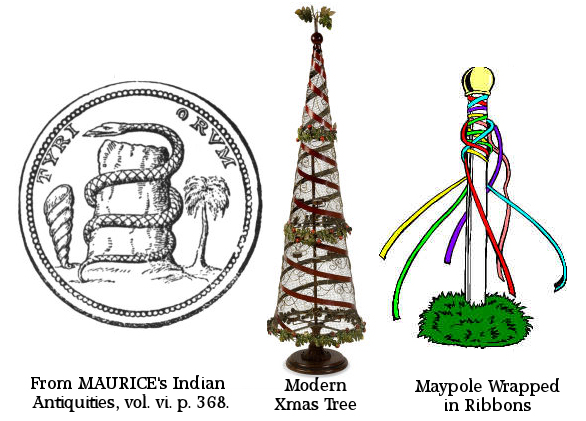
Some of the traditional "offerings" hung on the Christmas Fir Tree are balls, bells and lights. The red and gold balls represent the sun and moon (gods), the golden bells were shaped like pine cones (which were incidentally also shaped like the uterus through which the child saviour would be born) the lights (initially candles) represented the living souls who were being offered to the god. For this reason also, dollies and statuettes were hung on the tree. In an earlier more violent past, skulls were hung on the fir trees as a victory thankyou to the gods. (Notice also that the tree-pole used in the May celebrations is topped with a golden sun-ball.)
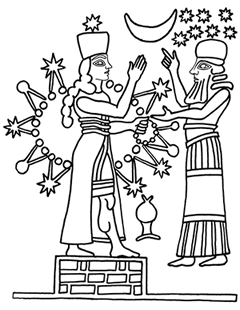 The STAR atop the tree is often said to be the "Star of Bethlehem" but in fact is nothing of the kind. It is the emblem of ASTARTE or ISHTAR (The Ashteroth of the Bible) and Venus, the morning and evening star) The course of the star Venus draws a perfect five-pointed star around the sun every forty years.
The STAR atop the tree is often said to be the "Star of Bethlehem" but in fact is nothing of the kind. It is the emblem of ASTARTE or ISHTAR (The Ashteroth of the Bible) and Venus, the morning and evening star) The course of the star Venus draws a perfect five-pointed star around the sun every forty years.
Here on a Neo-Assyrian seal, dated 883-612 BC we see " Ishtar-of-the-Stars" being worshipped and she has a star on top just as does the Christmas tree today.
The May Tree
The May "Pole" around which young girls dance (a throw-back to the fertility rites in Springtime) is of course yet another TREE.
This is how the Puritan writer, Phillip Stubbes in his "Anatomie of Abuses" (1583) described the May pole ceremonies:
"Against May, Whitsunday or other time, all the young men and maids, old men and wives, run gadding over night to the woods, groves, hills and mountains, where they spend all night in pleasant pastimes; and in the morning they return, bringing with them birch and branches of trees to deck their assemblies withal. And no marvel, for there is a great lord present among them, namely satan, prince of hell.
But the chiefest jewel they bring from thence is their Maypole, which they bring home with great veneration...this Maypole (this stinking idol, rather) is covered all over with flowers and herbage, bound round about with string from the top to the bottom and sometimes painted with various colours, with two or three hundred men, women and children following it with great devotion. And thus being reared up, with handkerchiefs and flags hovering on the top, they straw the ground round about, bind green boughs about it, set up summer huts, bowers and arbours hard by it, and then they fall to dance about it, like as the heathen people did at the dedication of the idols, whereof this is the perfect pattern, or rather, the thing itself.
I have heard it credibly reported that of forty, sixty or a hundred maids going to the wood overnight, there have scarcely the third part of them returned home again undefiled."
This account of the rice-planting ceremony in Bengal is remarkably similar:
"A party of young people go to the forest and cut a young Karma-tree. Bearing it in triumph they return singing, dancing and beating drums, and plant it in the middle of the village dancing-ground. A sacrifice is offered to the tree; next morning the youths, linked arm-in-arm, dance in a great circle round the tree, which is decked with strips of coloured cloth and plaited straw".
The tree is possibly the most basic and important pagan religious symbol, being used world-wide.
- The Tree of Light used at the Buddhist feast of the dead is decorated with candles to represent souls.
- On the fir tree of Woden, luminous balls represented sun, moon and stars.
- The Mithraic sacred tree is the pine
- Osiris is worshipped as the palm tree
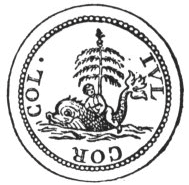
- In Rome the sacred tree was the fir, and the god was known as Baal-Berith (Lord of the Fir) But this title was taken from earlier Phoenician worship - see below. (Hebrew berot = fir tree)
- Melikerta, under the name of Palaemon, is represented with the fir-tree, or pine, the emblem of Baal-Bereth, "Lord of the Covenant," as his ensign. The Greeks did not know where Palaemon got his name. Some believe his original name, Melikertes, was derived from the god Melkart from the Phoenician distortion. The bible mentions this god: Zephaniah 1:5
- Dionysus, or Bacchus, was a god of wine and trees, and his image was often a draped tree. Particularly sacred to him was the pine tree, and the Delphic Oracle commanded the Corinthians to worship the pine tree "equally with the God".
The worship of Attis included the felling of a pine tree which was brought into the sanctuary of Cybele where it was treated as a great divinity. The trunk was swathed as a corpse with woollen bands and decked with wreaths of flowers, and the effigy of Attis was tied to the stem.
It appears from this that the tree was more representative of death than life. It is the death of the gods which makes their trees objects of worship, and it was by the death of a human representative of the god that the tree-god was honoured. Those offered to Odin were - predictably - hanged upon a tree and speared; the sacrifices to Attis were tied to the tree and flayed to death. Artemis appears to have been hanged annually either in effigy or by a representative in her sacred grove of Condylea in Arcadia. In that place she went by the name of The Hanged One. The Greeks, too, sacrificed animals in this way.
How can we forget that Jesus our Saviour hung on a tree for our sakes? He fulfilled all the types and symbols in himself, rendering ALL other religions and rites null and void. We no longer need the symbols. We have the REALITY, the Living Lord.
The Log, so symbolic of Christmas celebrations, is only a smaller version of the complete tree. It is burned (sacrificed) on Christmas Eve and resurrected on Christmas Day as the Christmas Tree. Although the customs surrounding the Log are dying out as central heating replaces open fires, the Log still remains one of the central features of Christmas celebrations, and the chocolate version graces many a Christmas table on the day.
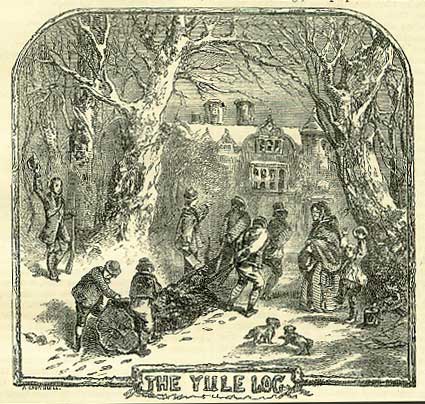 It
has been said that the Log is all that now remains of the ancient fire
festivals of Winter, and to some extent this is true.
It
has been said that the Log is all that now remains of the ancient fire
festivals of Winter, and to some extent this is true.
But it must be remembered that the smaller log is the product of the parent tree: the saviour-child born at the Solstice was a new incarnation of the ‘father-god’ after he had been killed.
In the Bible, Eden's Tree of Life returns to mankind as the Branch, shooting afresh from the roots of Jesse. (Isa 11:1-2). . See also Isaiah 61,3b for the use of the tree as ‘mighty one’ and Daniels’s interpretation of the tree vision (Dan 4).
Thus, the Yule Log is destroyed by the fire and raised again as the pine tree. This may remind some of the Phoenix bird of Egypt which dies in fire but is reborn from the ashes after three days. The symbolism of this was such that the Church once used the Phoenix to illustrate the death and resurrection of Christ.
But what is the hidden link between the Yule Log and the Phoenix bird? The Greek word PHOINIX means PALM TREE!
Christmas is, supremely, a festival of fire and light. Towns, cities, and neighbourhoods contest with one another in the brightness and ingenuity of their lights and flashing tree decorations are everywhere. Candles, too, figure prominently in church services and house decorations and are a potent symbol of Christmas.
Not just Christmas but all the winter festivals are all associated with fire. Each of the four winter solstice months once had its own fire festival:
- In November it was Samhain or Halloween (now becoming more and more popular)
- In the UK, Bonfire Night is November 5th, neatly coinciding with the old date of Samhain.
- December was the true sun solstice, with the candles on the trees.
- In January were New Year and Twelfth Night,
- February was the Celtic Imbolc, the ancient ‘Festival of Lights’ which the Church adopted as Candlemas.
(This latter feast of "Candlemass" was enhanced by Pope Sergius (from 687 to 701) as a substitute for a Roman feast day. In Rome, the first of February was a festival of candles and torch-lit processions when they honoured the deity Februa/Februis in a ritual purification of the city. When the Pope saw the Christians hankering after this festival, he used the feast of Candlemas for the Purification of the Virgin after childbirth as an opportunity for people to indulge in their own candle processions. ).
The beliefs and ceremonies of fire festivals throughout the year and around the world are remarkably similar:
- dancing in a circle
- singing or shouting
- burning a certain representative object - a straw effigy, tree or dummy
- sometimes a fir tree dressed in clothes or a ‘straw man’ was burnt. The Druidical practise at the time of the Roman invasion was noted by various historians of that time. Once every five years an enormous wicker-work ‘man’ was made which was filled with prisoners and animals and then burnt.
- after the flames have died down, leaping across the bonfire for good luck and fertility. (Often, this was young women or young couples hand-in-hand, but animals used to be driven through the dying embers too. See here)
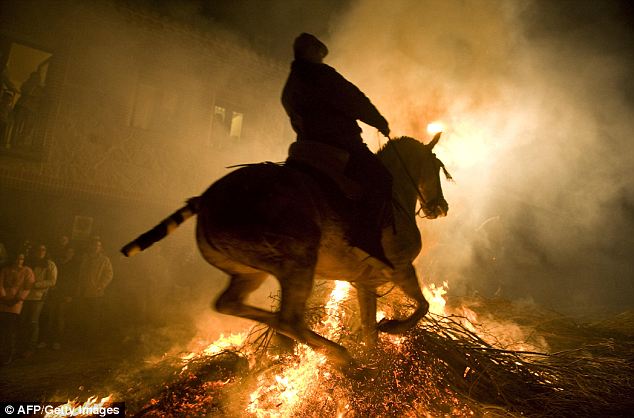
In an illustration by Thomas Schuller (1863) couples are shown leaping across St John's Bonfire in Alsace, France in 1830. It is accompanied by the incantation to Apollo, the sun-god noted by the poet Virgil. It says:
"…whom first we serve; whole woods of unctuous pine,
are felled for thee, and to thy glory shine.
By thee protected, with our naked soles,
Through flames unsinged we march and tread the kindled coals."
A significant feature of the bonfire party in many places is the special cake which was divided amongst those present, the one who chose the blackened or marked portion being treated as a victim of some sort. The others, for instance, would make as if to throw him into the flames. In Scotland, the victim would be spoken of all year as having DIED. This will make more sense as we come on to the origins of the puddings and mince-pies of Christmas.
Footnote:
(1) See this site for information about Santa http://www.av1611.org/othpubls/santa.html
(3) The Disa or Isa of the north was represented by a conic figure enveloped in a net, but instead of having the serpent coiled round it as for Appollo it is terminated in a human head. (01. Rudbeck, Jillcmt. vol. 2, c. 5, p. 219.) This goddess is unquestionably the Isis whom the ancients worshipped (Germ. c. 9.); for the initial letter of the first name appears to be an article or prefix joined to it; and the Egyptian Isis was occasionally represented enveloped in a net, exactly as the Scandinavian goddess was at Upsal.
Continue to PART THREE
© 2013 Tricia Tillin-Booth. All rights reserved. Birthpangs Website: http://www.birthpangs.org/ This document is the property of its author and is not to be displayed on other websites, redistributed, sold, reprinted, or reproduced in printed in any other format without permission. Websites may link to this article, if they provide proper title and author information. One copy may be downloaded, stored and/or printed for personal research. All spelling and phraseology is UK English.


